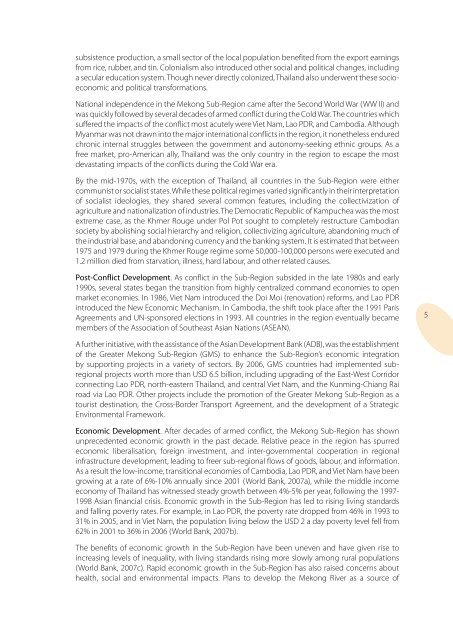Asia and the Pacific Education for All (EFA) mid-decade assessment ...
Asia and the Pacific Education for All (EFA) mid-decade assessment ...
Asia and the Pacific Education for All (EFA) mid-decade assessment ...
Create successful ePaper yourself
Turn your PDF publications into a flip-book with our unique Google optimized e-Paper software.
subsistence production, a small sector of <strong>the</strong> local population benefited from <strong>the</strong> export earnings<br />
from rice, rubber, <strong>and</strong> tin. Colonialism also introduced o<strong>the</strong>r social <strong>and</strong> political changes, including<br />
a secular education system. Though never directly colonized, Thail<strong>and</strong> also under went <strong>the</strong>se socioeconomic<br />
<strong>and</strong> political trans <strong>for</strong> ma tions.<br />
National independence in <strong>the</strong> Mekong Sub-Region came after <strong>the</strong> Second World War (WW II) <strong>and</strong><br />
was quickly followed by several <strong>decade</strong>s of armed conflict during <strong>the</strong> Cold War. The countries which<br />
suffered <strong>the</strong> impacts of <strong>the</strong> conflict most acutely were Viet Nam, Lao PDR, <strong>and</strong> Cambodia. Although<br />
Myanmar was not drawn into <strong>the</strong> major international conflicts in <strong>the</strong> region, it none<strong>the</strong>less endured<br />
chronic internal struggles between <strong>the</strong> government <strong>and</strong> autonomy-seeking ethnic groups. As a<br />
free market, pro-American ally, Thail<strong>and</strong> was <strong>the</strong> only country in <strong>the</strong> region to escape <strong>the</strong> most<br />
devastating impacts of <strong>the</strong> conflicts during <strong>the</strong> Cold War era.<br />
By <strong>the</strong> <strong>mid</strong>-1970s, with <strong>the</strong> exception of Thail<strong>and</strong>, all countries in <strong>the</strong> Sub-Region were ei<strong>the</strong>r<br />
communist or socialist states. While <strong>the</strong>se political regimes varied significantly in <strong>the</strong>ir interpretation<br />
of socialist ideologies, <strong>the</strong>y shared several common features, including <strong>the</strong> collectivization of<br />
agriculture <strong>and</strong> nationalization of industries. The Democratic Republic of Kampuchea was <strong>the</strong> most<br />
extreme case, as <strong>the</strong> Khmer Rouge under Pol Pot sought to com pletely restructure Cambodian<br />
society by abolishing social hierarchy <strong>and</strong> religion, collectiviz ing agriculture, ab<strong>and</strong>oning much of<br />
<strong>the</strong> industrial base, <strong>and</strong> ab<strong>and</strong>oning currency <strong>and</strong> <strong>the</strong> banking system. It is estimated that between<br />
1975 <strong>and</strong> 1979 during <strong>the</strong> Khmer Rouge regime some 50,000-100,000 persons were executed <strong>and</strong><br />
1.2 million died from starvation, illness, hard labour, <strong>and</strong> o<strong>the</strong>r related causes.<br />
Post-Conflict Development. As conflict in <strong>the</strong> Sub-Region subsided in <strong>the</strong> late 1980s <strong>and</strong> early<br />
1990s, several states began <strong>the</strong> transition from highly centralized comm<strong>and</strong> economies to open<br />
market economies. In 1986, Viet Nam introduced <strong>the</strong> Doi Moi (renovation) re<strong>for</strong>ms, <strong>and</strong> Lao PDR<br />
introduced <strong>the</strong> New Economic Mechanism. In Cambodia, <strong>the</strong> shift took place after <strong>the</strong> 1991 Paris<br />
Agreements <strong>and</strong> UN-sponsored elections in 1993. <strong>All</strong> countries in <strong>the</strong> region eventually became<br />
members of <strong>the</strong> Association of Sou<strong>the</strong>ast <strong>Asia</strong>n Nations (ASEAN).<br />
5<br />
A fur<strong>the</strong>r initiative, with <strong>the</strong> assistance of <strong>the</strong> <strong>Asia</strong>n Development Bank (ADB), was <strong>the</strong> establishment<br />
of <strong>the</strong> Greater Mekong Sub-Region (GMS) to enhance <strong>the</strong> Sub-Region’s economic integration<br />
by supporting projects in a variety of sectors. By 2006, GMS countries had implemented subregional<br />
projects worth more than USD 6.5 billion, including up grading of <strong>the</strong> East-West Corridor<br />
connecting Lao PDR, north-eastern Thail<strong>and</strong>, <strong>and</strong> central Viet Nam, <strong>and</strong> <strong>the</strong> Kunming-Chiang Rai<br />
road via Lao PDR. O<strong>the</strong>r projects include <strong>the</strong> promotion of <strong>the</strong> Greater Mekong Sub-Region as a<br />
tourist destination, <strong>the</strong> Cross-Border Transport Agreement, <strong>and</strong> <strong>the</strong> development of a Strategic<br />
Environmental Framework.<br />
Economic Development. After <strong>decade</strong>s of armed conflict, <strong>the</strong> Mekong Sub-Region has shown<br />
unprecedented economic growth in <strong>the</strong> past <strong>decade</strong>. Relative peace in <strong>the</strong> region has spurred<br />
economic liberalisation, <strong>for</strong>eign investment, <strong>and</strong> inter-governmental cooperation in regional<br />
infrastructure development, leading to freer sub-regional flows of goods, labour, <strong>and</strong> in<strong>for</strong>mation.<br />
As a result <strong>the</strong> low-income, transitional economies of Cambodia, Lao PDR, <strong>and</strong> Viet Nam have been<br />
growing at a rate of 6%-10% annually since 2001 (World Bank, 2007a), while <strong>the</strong> <strong>mid</strong>dle income<br />
economy of Thail<strong>and</strong> has witnessed steady growth between 4%-5% per year, following <strong>the</strong> 1997-<br />
1998 <strong>Asia</strong>n financial crisis. Economic growth in <strong>the</strong> Sub-Region has led to rising living st<strong>and</strong>ards<br />
<strong>and</strong> falling poverty rates. For example, in Lao PDR, <strong>the</strong> poverty rate dropped from 46% in 1993 to<br />
31% in 2005, <strong>and</strong> in Viet Nam, <strong>the</strong> population living below <strong>the</strong> USD 2 a day poverty level fell from<br />
62% in 2001 to 36% in 2006 (World Bank, 2007b).<br />
The benefits of economic growth in <strong>the</strong> Sub-Region have been uneven <strong>and</strong> have given rise to<br />
increasing levels of inequality, with living st<strong>and</strong>ards rising more slowly among rural populations<br />
(World Bank, 2007c). Rapid economic growth in <strong>the</strong> Sub-Region has also raised concerns about<br />
health, social <strong>and</strong> environmental impacts. Plans to develop <strong>the</strong> Mekong River as a source of

















